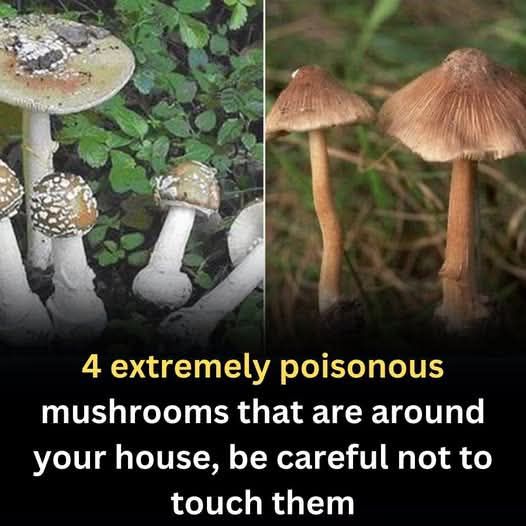ADVERTISEMENT
4 Extremely Poisonous Mushrooms That Could Be Around Your House: Be Careful Not to Touch Them
Mushrooms are a fascinating part of nature, often found growing in forests, gardens, or even in your own backyard. While many are harmless, some can be highly toxic and pose serious health risks if ingested. In fact, certain poisonous mushrooms can be deadly, and they might be growing right outside your door. Understanding how to identify these dangerous fungi can help you avoid them and keep you and your loved ones safe.
In this article, we’ll highlight four extremely poisonous mushrooms that could be lurking around your home. It’s crucial to note that never touch or eat wild mushrooms unless you are absolutely certain of their identity. If you suspect that someone has ingested a poisonous mushroom, seek medical help immediately. Now, let’s take a closer look at these deadly mushrooms.
1. Amanita phalloides (Death Cap)
Appearance:
- Cap: The Death Cap has a smooth, greenish-yellow or olive-colored cap that can range from 5 to 15 cm wide. It can sometimes appear slightly sticky or slimy, especially after rain.
- Gills: White, free gills (not attached to the stem).
- Stem: The stem is white with a bulbous base, and it has a volva (a sac-like structure at the base of the stem).
- Spore Print: White.
Why It’s Dangerous: The Death Cap is one of the most toxic mushrooms in the world and can be fatal if ingested. Even a small amount of this mushroom can cause severe liver and kidney damage, and death may occur within 6 to 12 days after consumption. The toxins in the Death Cap attack the liver and kidneys, often leading to organ failure.
The scariest part is that it looks very similar to some edible mushrooms, especially the common puffball or certain types of field mushrooms. It’s crucial to never forage for mushrooms unless you’re experienced in identifying them and are 100% sure of their safety.
2. Amanita muscaria (Fly Agaric)
Appearance:
- Cap: Bright red or orange with white spots, though the color can vary depending on the age and environment of the mushroom.
- Gills: White gills.
- Stem: White stem with a bulbous base, often with a ring around the upper part of the stem.
- Spore Print: White.
Why It’s Dangerous: Although not usually fatal, the Fly Agaric can cause serious poisoning symptoms, including confusion, delirium, nausea, vomiting, and hallucinations. This mushroom contains psychoactive compounds such as muscarine, ibotenic acid, and muscimol, which affect the central nervous system. Ingestion can lead to severe toxicity, and in large quantities, it may cause death.
This mushroom is known for its striking appearance, but don’t be fooled by its beauty. It’s best to admire it from a distance, as even small amounts can cause distressing symptoms.
3. Galerina marginata (Deadly Galerina)
Appearance:
- Cap: Brown, conical to bell-shaped, and can range from 1 to 5 cm in diameter. The cap often has a yellow-brown center and a lighter edge.
- Gills: Brownish, with a distinct spacing pattern.
- Stem: Thin, pale, with a ring-like structure on the upper part.
- Spore Print: Rusty brown.
Why It’s Dangerous: The Deadly Galerina contains the same toxins as the Death Cap, specifically amatoxins, which cause severe liver damage and can lead to death. It typically grows on decaying wood, logs, and stumps, which are common places around gardens or wooded areas.
Because the Deadly Galerina looks very similar to edible mushrooms, including the common honey fungus, it’s especially dangerous for those who forage. Like the Death Cap, this mushroom can be deadly even in small amounts.
4. Conocybe filaris (False Death Cap)
Appearance:
- Cap: White to yellowish with a smooth texture, usually 5 to 8 cm wide.
- Gills: White, closely spaced, and free from the stem.
